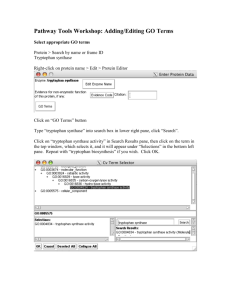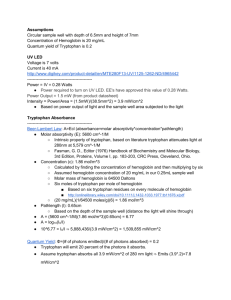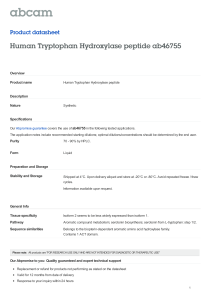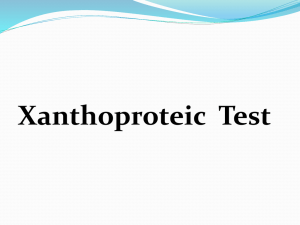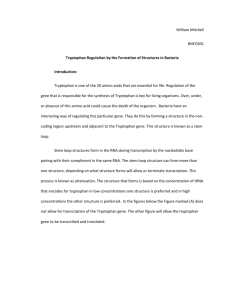Transport of Tryptophan into SH-SY5Y Neuronal Cells
advertisement
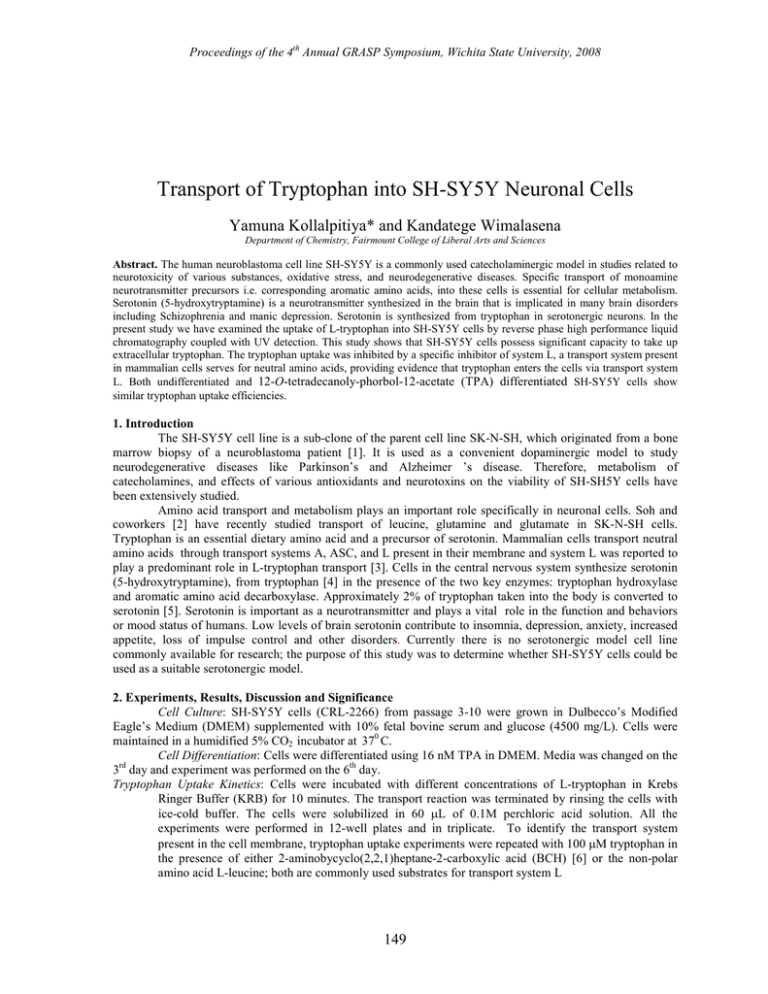
Proceedings of the 4th Annual GRASP Symposium, Wichita State University, 2008 Transport of Tryptophan into SH-SY5Y Neuronal Cells Yamuna Kollalpitiya* and Kandatege Wimalasena Department of Chemistry, Fairmount College of Liberal Arts and Sciences Abstract. The human neuroblastoma cell line SH-SY5Y is a commonly used catecholaminergic model in studies related to neurotoxicity of various substances, oxidative stress, and neurodegenerative diseases. Specific transport of monoamine neurotransmitter precursors i.e. corresponding aromatic amino acids, into these cells is essential for cellular metabolism. Serotonin (5-hydroxytryptamine) is a neurotransmitter synthesized in the brain that is implicated in many brain disorders including Schizophrenia and manic depression. Serotonin is synthesized from tryptophan in serotonergic neurons. In the present study we have examined the uptake of L-tryptophan into SH-SY5Y cells by reverse phase high performance liquid chromatography coupled with UV detection. This study shows that SH-SY5Y cells possess significant capacity to take up extracellular tryptophan. The tryptophan uptake was inhibited by a specific inhibitor of system L, a transport system present in mammalian cells serves for neutral amino acids, providing evidence that tryptophan enters the cells via transport system L. Both undifferentiated and 12-O-tetradecanoly-phorbol-12-acetate (TPA) differentiated SH-SY5Y cells show similar tryptophan uptake efficiencies. 1. Introduction The SH-SY5Y cell line is a sub-clone of the parent cell line SK-N-SH, which originated from a bone marrow biopsy of a neuroblastoma patient [1]. It is used as a convenient dopaminergic model to study neurodegenerative diseases like Parkinson’s and Alzheimer ’s disease. Therefore, metabolism of catecholamines, and effects of various antioxidants and neurotoxins on the viability of SH-SH5Y cells have been extensively studied. Amino acid transport and metabolism plays an important role specifically in neuronal cells. Soh and coworkers [2] have recently studied transport of leucine, glutamine and glutamate in SK-N-SH cells. Tryptophan is an essential dietary amino acid and a precursor of serotonin. Mammalian cells transport neutral amino acids through transport systems A, ASC, and L present in their membrane and system L was reported to play a predominant role in L-tryptophan transport [3]. Cells in the central nervous system synthesize serotonin (5-hydroxytryptamine), from tryptophan [4] in the presence of the two key enzymes: tryptophan hydroxylase and aromatic amino acid decarboxylase. Approximately 2% of tryptophan taken into the body is converted to serotonin [5]. Serotonin is important as a neurotransmitter and plays a vital role in the function and behaviors or mood status of humans. Low levels of brain serotonin contribute to insomnia, depression, anxiety, increased appetite, loss of impulse control and other disorders. Currently there is no serotonergic model cell line commonly available for research; the purpose of this study was to determine whether SH-SY5Y cells could be used as a suitable serotonergic model. 2. Experiments, Results, Discussion and Significance Cell Culture: SH-SY5Y cells (CRL-2266) from passage 3-10 were grown in Dulbecco’s Modified Eagle’s Medium (DMEM) supplemented with 10% fetal bovine serum and glucose (4500 mg/L). Cells were maintained in a humidified 5% CO2 incubator at 370 C. Cell Differentiation: Cells were differentiated using 16 nM TPA in DMEM. Media was changed on the 3rd day and experiment was performed on the 6th day. Tryptophan Uptake Kinetics: Cells were incubated with different concentrations of L-tryptophan in Krebs Ringer Buffer (KRB) for 10 minutes. The transport reaction was terminated by rinsing the cells with ice-cold buffer. The cells were solubilized in 60 µL of 0.1M perchloric acid solution. All the experiments were performed in 12-well plates and in triplicate. To identify the transport system present in the cell membrane, tryptophan uptake experiments were repeated with 100 µM tryptophan in the presence of either 2-aminobycyclo(2,2,1)heptane-2-carboxylic acid (BCH) [6] or the non-polar amino acid L-leucine; both are commonly used substrates for transport system L 149 Proceedings of the 4th Annual GRASP Symposium, Wichita State University, 2008 Quantification of Tryptophan Uptake: Tryptophan concentrations in the cell extracts were determined by reverse phase HPLC coupled with UV detection at 280 nm. The concentrations were calculated from a standard curve based on the peak area of authentic L-tryptophan under similar conditions. Results: Kinetic studies indicate that efficiency of L-tryptophan uptake of TPA-differentiated cells is slightly higher than that of undifferentiated cells as indicated by the corresponding Vmax/ Km parameters (Table 1). However the transport affinities (Km) are not significantly affected by differentiation. The Km values obtained in the present study are similar to the values reported for glutamine uptake into SK-N-SH cells by Soh and coworkers [ (2), 101±2 µM and for leucine 94±14 µM]. Table 1. Michaelis-Menten parameters of L- tryptophan transport into SH-SY5Y cells Undifferentiated cells Differentiated cells Vmax (pmol/mg/min) 972 ± 83 1367 ± 192 Km (µM) Vmax/ Km 113± 26 102± 34 8.5 13.5 Tryptophan level (pmol/mg of ptotein/min) About 70% inhibition of tryptophan uptake occurred when 1mM of either BCH or L-leucine was included in the tryptophan uptake media (Fig. 1). Complete inhibition was observed when the concentration of BCH was increased to 5 mM. As BCH and L-leucine are both substrates of system L, this provides evidence that tryptophan transport is also mediated by the system L. 800 600 400 200 0 control Leu in BCH in Fig. 1. Tryptophan uptake inhibition by BCH and Leucine 3. Conclusions Significant accumulation of L-tryptophan into SH-SY5Y neuroblastoma cells was observed and uptake appeared to be primarily mediated by the system L. The affinity of L-tryptophan to the transporter (Km) is comparable with the reported values for leucine and glutamine in the parent cell line SK-N-SH. We are currently investigating whether the intracellular tryptophan is converted to serotonin in these cells. 4. Acknowledgements This work was supported by National Institutes of Health Grant NS 39423. [1]Biedler, J. L., Soffler-Tarlov, S., Schachner, M., Freedman, L., S., (1978) Cancer Research 38, 3751-3757. [2]Soh, H., Wasa, M., Fukuzawa, M., (2007) J. Pediatr. Surg. 42, 608-612. [3]Harper, A., Pogson, C. I., Pearce, J., H., (2000) Infec. Immun. 68, 5439-5442 [4] Kema, I. P., Meijer, W. G., Meiborg, G., Ooms, B., Willemse, P. H. B., Vries, E. G. E., (2001) Clinical Chemistry 47, 1811-1820. [5].Sirek, A., Sirek, O., V., (1970) Can. Med. Asso. J. 102, 846-849. [6]Gazzola, G., C., Dall’s Asta, V., Guidotti, G., G., (1980) J. Biol. Chem. 255, 929-936 . 150
